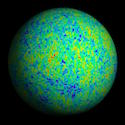|
|
On this page... (hide) Estimation of the noise covariance map of a smoothed datasets. 1. 1-D Polar covariance maps smoothingWhen smoothing a 1-D {$n$}-pixel map {$m$}, we convolve it with a Gaussian kernel {$K_\sigma$}, with $\sigma$ being the bandwidth. The resulting smoothed map at pixel {$p$} becomes {$ \tilde m_p = K_\sigma * m ~~~~~ \text{with} ~~~~~K_\sigma(p) \equiv \frac 1 {\sigma^2} \exp\left(\frac {p^2}{2\sigma^2}\right) $} with * the convolution product. Since we work in pixel space, the convolution becomes {$ \tilde m_p = \frac 1{ n_{}}\sum_{p'}^{n_{}} K_\sigma(p-p') m_{p'} $} From it, the covariance of the smoothed maps {$\tilde x$} and {$\tilde y$} then becomes {$ Cov[\tilde x_p, \tilde y_p] = Cov[K_\sigma * x, K_\sigma * y] $} {$ Cov[\tilde x_p, \tilde y_p] = K^2_\sigma * Cov[ x, y] $} {$ Cov[\tilde x_p, \tilde y_p] = \frac12\frac1{\sigma^2 n_{}} K_{\sigma/\sqrt2} * Cov[ x, y]. $} We conclude that the resulting covariance of two smoothed maps {$\tilde x$} and {$\tilde y$} by a Gaussian kernel {$K_\sigma$} is equivalent to the smoothing of the initial covariance map between {$ x$} and {$ y$} by a Gaussian kernel {$\displaystyle \frac{K_{\sigma/\sqrt 2}}{2\sigma^2 n_{}}$}. As a more detailed calculation, let {$ \tilde m(p) = \frac1{n} \sum_i^n K_\sigma(p-p') m(p') $} the value of the $n$-pixel smoothed map at pixel {$p$}, with {$\displaystyle K_\sigma(p) \equiv \frac 1 {\sigma^2} \exp\left(-\frac12 \frac{p^2}{\sigma^2}\right)$} the Gaussian smoothing kernel. Thus, {$ Var[\tilde m (p)] = E [\tilde m(p)^2] - E [\tilde m(p)]^2 $} {$ Var[\tilde m (p)] = E \left[\frac1 { n^2} \sum_i^n K_\sigma(p-p_i)m(p_i)\sum_j^n K_\sigma(p-p_j)m(p_j) \right] - \frac1 {n^2} \left( \sum_i^n K(p-p_i) \underbrace{E [m(p_i)]}_{=0} \right)^2 $} {$ Var[\tilde m (p)] = \frac1 {n^2} \left(\sum_i^n K_\sigma^2(p-p_i) E[m(p_i)^2] + \sum_{i\neq j}^n K_\sigma(p-p_i)K_\sigma(p-p_j)\underbrace{ E[m(p_i)m(p_j)]}_{=0}\right) $} {$ Var[\tilde m (p)] =\frac1 {n^2} \sum_i^n K_\sigma^2(p-p_i) Var[m(p_i)] $} {$ Var[\tilde m (p)] =\frac 12 \frac1 {\sigma^2 n} \left(\sum_i^n K_{\sigma/\sqrt2}(p-p_i) Var[m(p_i)]\right). $} Since {$ K_{\sigma}(p)^2 = \frac 1 {\sigma^4} \exp\left(-\frac{p^2}{\sigma^2}\right) = \frac 12\frac 1 {\sigma^2} K_{\sigma/\sqrt2}(p) $}
{$ K_{\sigma}(p)^2 = \frac 1 {\sigma^4} \exp\left(-\frac{p^2}{\sigma^2}\right) = \frac 1 {\sigma^2} K_{\sigma/\sqrt2}(p) $} 2. 2-D Polar covariance maps smoothing
3. Validation simulations
|
|

